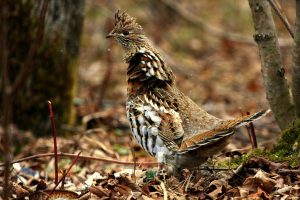Early successional forest habitat (ESH) and associated wildlife species in the northeastern United States are declining. NY Department of Environmental Conservation partnered with the Cornell University Human Dimensions Unit to determine how to support landowners interested in ESH management.
Early successional forest habitat (ESH) and associated wildlife species in the northeastern United States are declining. To help offset this decline, the 2005 NY Department of Environmental Conservation (DEC) Comprehensive Wildlife Conservation Strategy called for the engagement of private landowners to create and maintain early successional forest habitat (ESH) to benefit bird species such as American Woodcock, Ruffed Grouse, and Golden-winged Warblers.
NY DEC partnered with the Cornell University Human Dimensions Unit to determine how to support landowners interested in ESH management. Human dimensions researchers Ashley Dayer, Shorna Allred, and Rich Stedman conducted interviews, focus groups, and mail surveys of landowners in the Southern Tier of New York to understand landowners’ future intentions to manage their forests through even-aged timber harvest (a specific management practice that creates ESH) and what characteristics of the landowners or the land predicts this behavior. They also explored what policy tools (e.g., technical assistance, education materials, and financial incentives) would encourage landowners to manage for ESH, and how landowner interests in policy tools varies by type of landowner.
Research Insights
- The amount of early successional habitat created and managed by landowners could be enough to reach NY DEC bird conservation objectives if all landowners who indicated they were slightly likely to conduct even-aged management actually did so. Therefore, engagement with these landowners is important.
- Educational type tools such as landowner workshops, demonstration sites, or brochures are essential to encourage landowners to manage for early successional habitat. Financial incentives alone are not sufficient because many landowners do not believe that even-aged management helps wildlife.
Outcomes
Human dimensions information relating to how landowners prefer to receive information and what information they want to receive (e.g., key prospects, communications messages) was
incorporated into state agency staff trainings, a communications handbook for talking with forest landowners about ESH, and the Outreach Strategy for the New England Cottontail, another wildlife species that is reliant on ESH.
Additionally, human dimensions professionals and partners hosted a stakeholder workshop of conservation professionals and scientists interested in ESH management on private lands in NY to share knowledge and discuss challenges.
Additional Information
- Understanding landowner intentions to create early successional forest habitat in the northeastern United States
- Developing tools to encourage private forest landowners to participate in early successional forest habitat management
- New York’s Southern Tier landowners’ management for early successional forest habitat: attitudes, barriers, and motivations
To learn more about this project contact Ashley Dayer: dayer@vt.edu.


